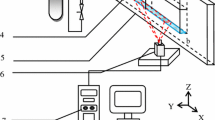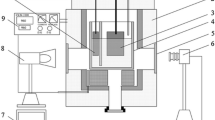Abstract
Bubbles play an important role in the transport phenomena existing in an electrolysis cell. They increase the total ohmic resistance of the electrolyte but their contribution is still not well quantified. During their movement under the anode, the bubbles are separated from the solid by the so-called wetting film, that is by a thin liquid layer. In order to develop a mathematical model to compute the increment of the electrical resistance of the electrolyte due to the presence of several bubbles under the anode, the effects of the bubble shape and the thickness of the wetting film for a single bubble must be quantified a priori. In this first paper, these effects are computed using the finite element method (FEM). The results have shown that the influence of the bubble shape and that of the wetting film is small, about 5% and 2%, respectively.












Similar content being viewed by others
Abbreviations
- A a :
-
anode area (m2)
- A p :
-
projected area (m2)
- A*:
-
cross-section of an electrical current tube (m2)
- b :
-
bubble front width (m)
- d :
-
bubble diameter (m)
- d eq :
-
equivalent diameter (m)
- \(\vec {E}\) :
-
electrical field (V/m)
- g :
-
gravitational acceleration (m s−2)
- h :
-
bubble height (m)
- i :
-
local current density (A m−2)
- \(\vec {i}\) :
-
current density vector (A m−2)
- I :
-
current (A)
- L C :
-
length of the elongated bubble (m)
- r :
-
geometrical ratio for large bubbles
- R 0 :
-
electrical resistance of the bubble-free electrolyte (Ω)
- R T :
-
total electrical resistance of the electrolyte with bubbles present (Ω)
- u T :
-
bubble terminal velocity (m s−1)
- V :
-
voltage (V)
- V*:
-
bubble volume (m3)
- κ:
-
electrical conductivity (Ω−1 m−1)
- Θ:
-
covering factor
- ρ:
-
density (kg m3)
- σ:
-
surface tension (N m)
- υ:
-
kinematic viscosity (m2 s−1)
- 1:
-
anode
- 2:
-
electrolyte
- A:
-
upper limit of the computational domain (within the anode)
- B:
-
cathode surface (bath-molten aluminium interface)
- l:
-
liquid phase
- n :
-
index of an element
- n :
-
normal component
- N :
-
number of element
- t :
-
tangential component
- *:
-
electrical current tube
References
K. Grjotheim and H. Kvande (eds.), ‘Introduction to Aluminium Electrolysis’, 2nd edn. (Aluminium-Verlag, 1993)
L.I. Kiss, S. Poncsák, D. Toulouse, A.L. Perron, A. Liedtke and V. Mackowiak, in L. Nastac and B.Q. Li (eds.), Light Metals Multiphase Phenomena and CFD Modeling and Simulation in Materials Processes (TMS, Warrendale, PA, 2004), pp. 159–167
Haupin W.E. (1971). J. Metals 23:46
Dernedde E., Cambridge E.L. (1975). In: Rentsch R. (eds) Light Metals. TMS, Warrendale, PA, pp. 111–122
Hyde T.M., Welch B.J. (1997). In: Huglen R. (eds) Light Metals. TMS, Warrendale, PA, pp. 333–340
R.J. Aaberg, V. Ranum, K. Williamson and B.J. Welch, in R. Huglen. (ed.), Light Metals (TMS, Warrendale, PA, 1997), pp. 341–346
Solheim A., Thonstad J. (1986). In: Miller R.B., Peterson W.S. (eds) Light Metals. TMS, Warrendale PA, pp. 397–403
Quian K., Chen D., Chen J.J.J. (1998). J. Appl. Electrochem. 28:1141
Zoric J., Solheim A. (2000). J. Appl. Electrochem. 30:787
Vogt H., Kleinschrodt H.D. (2003). J. Appl. Electrochem. 33:563
Perron A.L., Kiss L.I., Poncsák S. (2005). In: Kvande H. (eds) Light Metals. TMS, Warrendale, PA, pp. 565–570
Perron A.L., Kiss L.I., Poncsák S. (2006). Int. J. Multiphase Flow 32:606
Fortin S., Gerhardt M., Gesing A.J. (1984). In: McGeer J.P. (eds) Light Metals. TMS, Warrendale, PA, pp. 721–741
A.L. Perron, L.I. Kiss, S. Poncsák, Int. J. Multiphase Flow (2006) (in press)
Kiss L.I., Poncsák S. (2002). In: Schneider W. (eds) Light Metals. TMS, Warrendale, PA, pp. 217–223
L.I. Kiss, S. Poncsák and J. Antille. in H. Kvande (Ed.), Light Metal (TMS, Warrendale, PA, 2005), pp. 559–564
Poncsák S., Kiss L.I., Toulouse D., Perron A.L., Perron S. (2006). In: Galloway T.J. (eds) Light Metals. TMS, Warrendale, PA, pp. 457–462
Richards N., Gudbrandsen H., Rolseth S., Thonstad J. (2003). In: Crepeau P.N. (eds) Light Metals. TMS, Warrendale, PA, pp. 315–322
Acknowledgements
The first author gratefully acknowledges the support of the Fonds québécois de recherches sur la nature et les technologies (FQRNT) and that of the Conseil de Recherches en Sciences Naturelles et en Génie du Canada (CRSNG) in the form of post-graduate scholarships.
Author information
Authors and Affiliations
Corresponding author
Rights and permissions
About this article
Cite this article
Perron, A., Kiss, L. & Poncsák, S. The influence of bubble shape and the thickness of the wetting film on the incremental electrical resistance caused by the presence of a single bubble in Hall-Héroult cells. J Appl Electrochem 36, 1381–1389 (2006). https://doi.org/10.1007/s10800-006-9220-1
Received:
Accepted:
Published:
Issue Date:
DOI: https://doi.org/10.1007/s10800-006-9220-1




